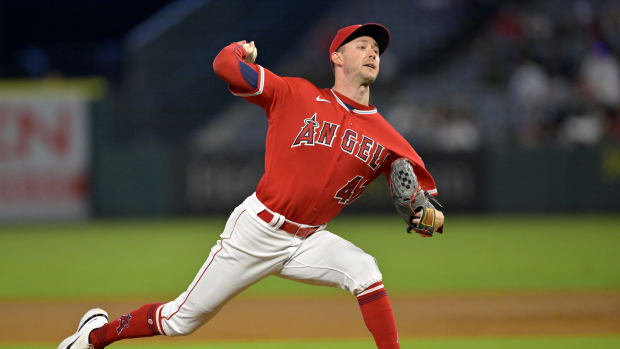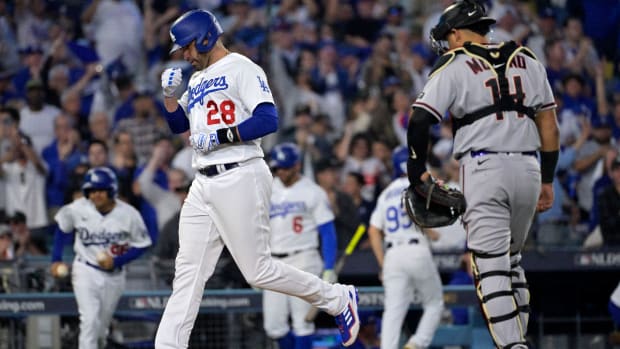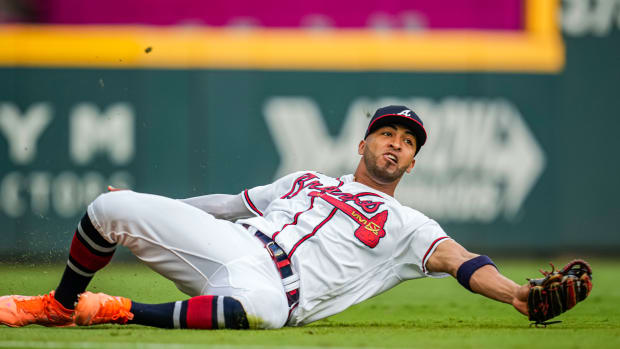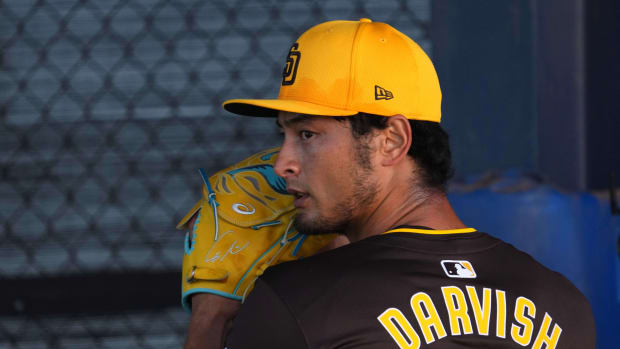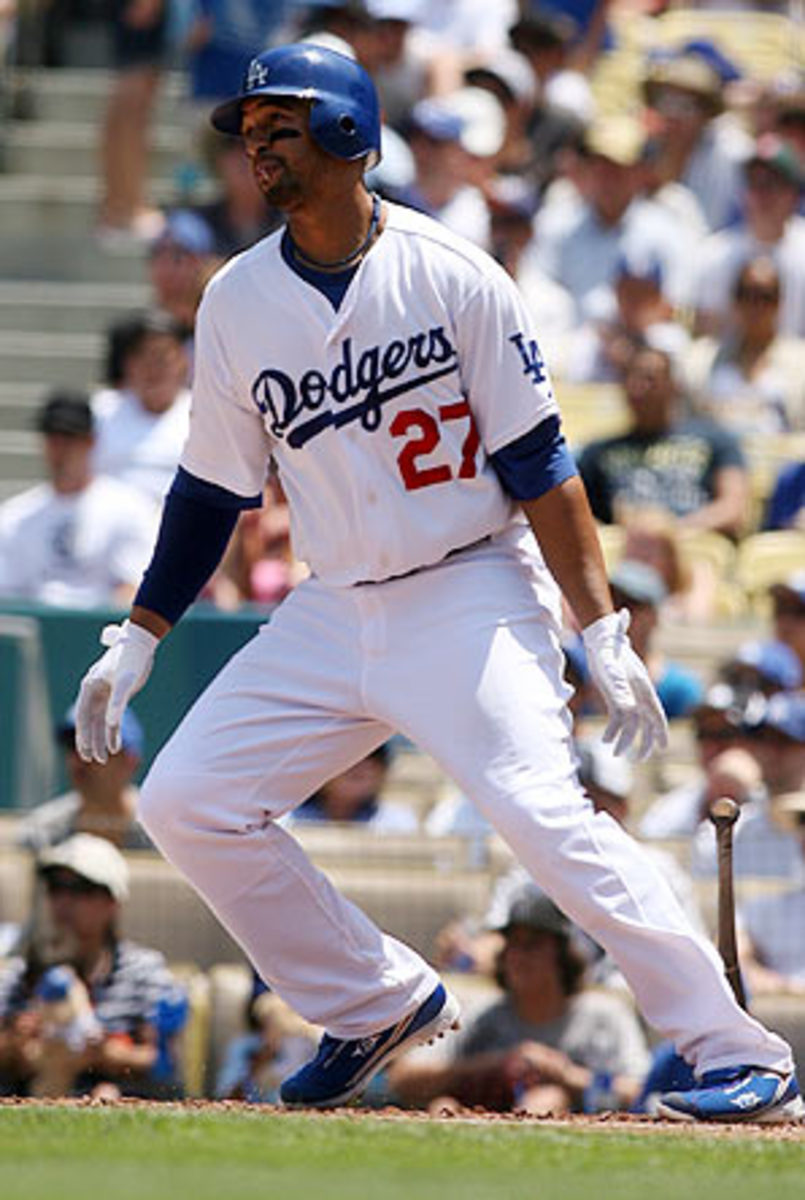
PECOTA 50: The best players to build a team around (50-26)
These rankings take advantage of several proprietary Baseball Prospectus tools, including our PECOTA projection system, which produces seven-year projections for each player based on his historical comparables. Adam Jones could be the next Willie Mays, for example -- or he could be the next Corey Patterson. However, we are by no means slave to the numbers, as this sort of list necessarily requires us to lean heavily on our instincts and scouting impressions. Rankings from last year's list are contained in parenthesis. For the honorable mention selections, click here. Today we will reveal players No. 50-26. Check back tomorrow for the top 25.
No. 50. Matt Kemp, CF, Dodgers, Age 23 (--)
Perhaps the Dodgers don't fully appreciate Kemp, having forced him to compete with Juan Pierre for playing time in the spring. But there's no reason that you shouldn't. Kemp has a lifetime .306 average, a big power hitters' body that should eventually produce 30 home runs per year, and plus speed that allows him to be a threat on the basepaths while looking surprisingly natural as a semi-regular center fielder. This is essentially the Andre Dawson skill set, and it still has room to grow.
No. 49. John Lackey, P, Angels, Age 29 (--)
Lackey has that sort of Chuck Knoblauch going on where he's been called 'underrated' so many times that he may now be overrated. But he's still been exceptionally consistent and exceptionally durable pitcher. The triceps injury that kept him out of action in April represented the first time that Lackey had ever been on the DL.
No. 48. Dan Uggla, 2B, Marlins, Age 28 (--)
Remarkably, three of the 50 most valuable players in baseball -- you'll see Josh Hamilton and Johan Santana making an appearance later -- were guys whose original employers were willing to let go of for $50,000 in the Rule 5 draft. Uggla strikes out as often as a left fielder -- but as long as he's hitting home runs like a left fielder, the Marlins aren't going to care.
No. 47. Geovany Soto, C, Cubs, Age 25 (--)
Completely off the prospect radar screen until last year, Soto has salvaged a dire situation at catcher for the Cubs. Since the start of the 2007 season, Geovany Soto has a VORP of 43.4, whereas Cubs' catchers not named Geovany Soto have a VORP of -7.6. Long-term, his career path should look a lot like Jorge Posada's.
No. 46. B.J. Upton, CF, Rays, Age 23 (No. 50)
He certainly hasn't matched his 2007 numbers, but because his walk rate has improved so much, he has contributed to his club even in a down year, with a .380 OBP thus far on the season. If Upton winds up being a Kenny Lofton rather than a Gary Sheffield, that is hardly a complete disaster.
No. 45. Carlos Beltran, CF, Mets, Age 31 (No. 12)
Beltran has lost a lot of ground in our rankings, but that's mostly just because he's been lapped by some younger talent. While Beltran does not have quite the power stroke that he once did, he still contributes to the Mets in all phases of the game, and has been the rare example of a Scott Boras contract that turned out well for the acquiring club.
No. 44. Howie Kendrick, 2B, Angels, Age 24 (No. 26)
Kendrick was arguably the best pure batting average prospect since Tony Gwynn, having been a .360 hitter over the course of his minor league career. Because of his recurrent injury problems, there is still a sense that we haven't quite seen all that he can do. Even if he merely winds up being a guy who hits .310 every year and bangs out 40 doubles, that is still a pretty valuable property in the middle infield.
No. 43. Carlos Zambrano, P, Cubs, Age 27 (No. 28)
Zambrano is just 27, but it feels like he's been around for a dozen seasons. Still, he remains one of the most enigmatic pitchers in baseball. Until this year, Zambrano had continued to rack up tons of wins in spite of his league-leading bases-on-balls totals in both 2006 and 2007. This year, he's revised his approach, getting his walk rate down to an acceptable number but experiencing a trade-off by missing fewer bats. Statistically speaking, he's still a No. 2 starter masquerading as a No. 1, but at some point you have to give deference to his adaptability, his durability, and his bat, which has produced 15 lifetime home runs.
No. 42. Edinson Volquez, P, Reds, Age 24 (--)
How often do you get a 15-5 record and a 2.73 ERA out of a 24-year-old pitcher ... and have to worry that you lost the trade that got him to you?
No. 41. Chad Billingsley, P, Dodgers, Age 23 (--)
Billingsley and Volquez have had nearly identical peripheral statistics this season -- Billingsley 162 strikeouts against 61 walks and 10 home runs, and Volquez 150 strikeouts against 70 walks and 10 home runs. We give preference to Billingsley because he is one year younger and has a deeper arsenal of pitches.
No. 40. Dustin Pedroia, 2B, Red Sox, Age 25 (--)
For years, PECOTA had been touting Pedroia, while scouts would not take him seriously. When Pedroia started out his major league career hitting .182 in April 2007, I thought I could see exactly what those scouts were seeing -- with his short stature and his uppercut swing, he looked like a Little Leaguer trying to hit major league pitching. I promptly traded him in my roto league. For Yuniesky Betancourt.
I should have kept the faith. And let's give the Red Sox credit for sticking with the gameplan. In a lot of organizations, like the Cubs or the Dodgers, Pedroia would have been banished to Triple-A, gotten frustrated, and wound up working at a car dealership.
No. 39. Roy Halladay, P, Blue Jays, Age 31 (No. 25)
He loses a little bit of position on this list each year as he ages, but one thing that augers well for his future is his pitch efficiency, as he's required just 3.60 pitches per plate appearances this season. Halladay may be the closest thing we have right now to vintage Greg Maddux.
No. 38. Mark Teixeira, 1B, Angels, Age 28 (No. 45)
Maybe he just requires a mid-season trade every year to really get him going. Teixeira differentiates himself from your ordinary slugger because of his outstanding defense, which has already won him two Gold Gloves and deserves more. As an aside, the word 'Teixeira' now appears in the Microsoft Word spell-check dictionary because of a complaint I made in the originial version of this column.
No. 37. Rich Harden, P, Cubs, Age 26 (HM)
We said at the outset that this list is all about upside. So I'm willing to accept some injury risk for pitchers -- provided that they can be this good when healthy.
No. 36. Lance Berkman, 1B, Astros, Age 32 (No. 32)
I had to think carefully about whether I was overrating older first basemen after getting burned badly on David Ortiz and Travis Hafner from last year's rankings. But his pudgy appearance aside, Berkman is a notably better athlete than either of those guys ever were, and he certainly has had no trouble with the stick.
No. 35. Prince Fielder, 1B, Brewers, Age 24 (No. 47)
Prince's power stroke has fully returned after getting off to a little bit of a slow start this season, perhaps because of the vegetarian diet that he adopted over the winter. Let's hope that staying cheeseburger-free will help Prince to trim down a bit, because as good as his bat is, this body type doesn't lend itself to long careers.
No. 34. Nick Markakis, RF, Orioles, Age 24 (--)
Believe it or not, the Orioles actually placed two young hitters in the Top 50, and another into Honorable Mention. Markakis is probably never going to be a huge power hitter, but with a great line-drive stroke and an even better batting eye, he'll be a top-of-the-order hitter for years to come.
No. 33. Jimmy Rollins, SS, Phillies, Age 29 (No. 48)
So who's the real Jimmy Rollins? Last year's MVP version, or the merely good player that he's been this year? Actually, I don't think this is all that difficult to resolve: Rollins is a very good player who had a career year, which happens not infrequently when a player is near his age 26-28 peak.
No. 32. Matt Wieters, C, Orioles, Age 22 (--)
Here is the other Oriole -- and the only current minor leaguer to make our Top 50. Since last season, we have significantly revised our minor league forecasts to make them more conservative ... but Wieters still blows the system out of the park, with a 1.038 OPS thus far on the season in spite of playing in some pitcher-friendly environments. Wieters might be in the upper quartile of major league catchers if he put on an Orioles uniform right now -- and he's only 22.
No. 31. Dan Haren, P, Diamondbacks, Age 27 (--)
Here's a guy who just really understands how to pitch, mixing in fastball, spitter and slider in perfect ratios. PECOTA likens him to a young Curt Schilling, which sounds just about right.
No. 30. Ryan Zimmerman, 3B, Nationals, Age 23 (No. 11)
Like nearly everyone else in Washington -- and I don't just mean the Nationals -- he's had an off year. But let's look at the resume: a bat that was good enough to be considerably better than league average by the time Zimmerman was 21 ... Gold Glove-caliber defense that still goes underappreciated ... his star has dimmed just a bit, but Zimmerman is still a franchise player.
No. 29. Ian Kinsler, 2B, Rangers, Age 26 (HM)
His profile is starting to look a little bit like vintage Jeff Kent, a fellow late bloomer who had always projected as a decent bat, and then wound up being a borderline great one. In fact, Kinsler is a considerably better athlete than Kent and also plays superior defense. Just keep him away from pick-up trucks.
No. 28. Joba Chamberlain, P, Yankees, Age 22 (--)
PECOTA tends to be extremely conservative with young pitchers, but before the year began, it had Joba rated as the No. 2 prospect in baseball, trailing only Evan Longoria. In spite of all the consternation about whether he should start or relieve, and in spite of his presently being on the disabled list, Chamberlain has really done everything to live up to PECOTA's expectations, having stuck out 10.5 batters per nine innings. Joba does feel like he might be the case where the star that burns twice as bright burns half as long, so I don't necessarily expect a 15-year career, but I do expect some outstanding performances over the next half-dozen seasons.
No. 27. Matt Holliday, LF, Rockies, Age 28 (--)
His career batting marks away from Coors Field are a .280 batting average, .346 on-base percentage, and .459 slugging average, which is pretty close to league-average for a corner outfielder. But a player should not be punished just because he happens to have adapted himself exceptionally well to his home environment, and Holliday is an underrated defender -- something that would play well just about anywhere.
No. 26. Russell Martin, C, Dodgers, Age 25 (HM)
This is really one of the half-dozen most unique skill sets in baseball, with significantly above-average speed for a catcher, Gold Glove defense, and an outstanding plate approach. But a lot of Martin's value stems not from the fact that he plays better than other catchers so much as that he plays so much more than other catchers. It is exceptionally rare for a catcher to work his way into as many as 150 ballgames in today's environment, yet Martin did that last year and he should be on pace to do it again this year, even if occasionally has to cheat by playing third base.






























